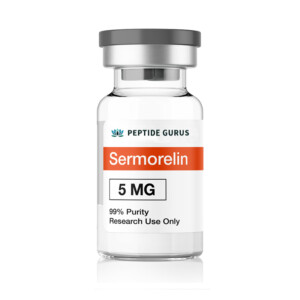Introduction
Sermorelin, a synthetic peptide, has been a subject of interest in various medical research areas. It is designed to mimic the action of the naturally occurring growth hormone-releasing hormone (GHRH). By binding to the growth hormone – releasing hormone receptor, it stimulates the pituitary gland to release growth hormone. This mechanism has been well – studied in the context of growth disorders, such as in children with growth hormone deficiency, where
Sermorelin has been used to increase the production of growth hormone.
Potential in Epilepsy Treatment Research
The Link between Growth Hormone and Epilepsy
Recent research has been exploring the potential role of growth hormone and related peptides like Sermorelin in epilepsy treatment. Some studies suggest that there might be a connection between the growth hormone system and the regulation of seizures. Growth hormone is involved in various physiological processes, including cell growth, repair, and neurotransmitter regulation. In the brain, these functions could potentially impact the excitability of neurons, which is a key factor in epilepsy.
How Sermorelin Might Intervene
Sermorelin, by stimulating growth hormone release, could potentially modulate the brain’s neural circuitry. It may influence the balance between excitatory and inhibitory neurotransmitters. For example, an increase in growth hormone might enhance the function of inhibitory neurons, which could help to dampen the excessive electrical activity in the brain that leads to seizures. Additionally, growth hormone has been associated with promoting neuroplasticity, the brain’s ability to reorganize its neural connections. This could be beneficial in epilepsy treatment, as it may help the brain to develop alternative pathways and reduce the frequency and severity of seizures.
FDA Guidelines and Considerations
The FDA has strict guidelines regarding the use of drugs and peptides in medical treatments. For peptides like Sermorelin, especially when being investigated for new indications such as epilepsy treatment, there are several aspects to consider.
Safety Evaluation
Before any peptide can be widely used for a new medical condition, its safety must be thoroughly evaluated. The FDA requires comprehensive pre – clinical and clinical trials to assess potential side effects. In the case of Sermorelin, common side effects in its traditional use (such as for growth hormone stimulation) include pain, redness, or swelling at the injection site. However, when considering its use in epilepsy, researchers need to look for any new or additional side effects that may occur due to its interaction with the brain’s complex neural systems.
Efficacy Trials
Proving the efficacy of Sermorelin in treating epilepsy is another crucial aspect. Clinical trials need to be designed to accurately measure the impact of Sermorelin on seizure frequency, severity, and duration. These trials should involve a sufficient number of patients and appropriate control groups to ensure that any observed effects are truly due to Sermorelin and not simply chance or other factors.
Product – Specific Information
Our Sermorelin product, available in a 5mg form, is carefully formulated. It is important to note that this product should only be used under the supervision of a healthcare professional, especially when considering its use in experimental or off – label applications such as epilepsy research. The product should be stored in the refrigerator as per the standard storage guidelines for Sermorelin to maintain its stability and effectiveness.
Common Questions and Answers
Question 1: Can Sermorelin completely cure epilepsy?
Answer: Currently, there is no evidence to suggest that Sermorelin can completely cure epilepsy. While research is exploring its potential to reduce seizure frequency and severity, epilepsy is a complex neurological disorder, and a single treatment is unlikely to provide a complete cure. Most epilepsy treatments, including potential ones with Sermorelin, aim to manage the symptoms rather than eliminate the underlying cause.
Question 2: Are there any long – term side effects of using Sermorelin for epilepsy treatment?
Answer: Since Sermorelin’s use in epilepsy treatment is still in the research phase, long – term side effects are not yet fully known. In its traditional use for growth hormone – related purposes, short – term side effects like injection – site reactions are common. But when used in the context of the brain for epilepsy, it may have different long – term effects. Further research and long – term clinical trials are needed to accurately determine these potential side effects.
Question 3: How does Sermorelin compare to existing epilepsy medications?
Answer: Existing epilepsy medications work through various mechanisms, such as blocking sodium channels, enhancing GABAergic inhibition, or modulating neurotransmitter release. Sermorelin, on the other hand, may work by stimulating growth hormone release and potentially influencing neural plasticity and neurotransmitter balance in a different way. While existing medications have been proven effective in many patients, some may have significant side effects. The advantage of Sermorelin, if proven effective, could be a different side – effect profile and a novel approach to treating epilepsy. However, more research is required to make a proper comparison.
